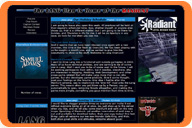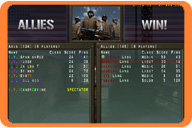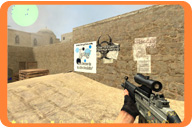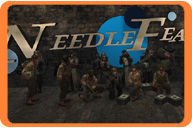Early Days (2002)
In the Beginning
The story of Lang begins in late 2001. Matthew "Java" Evert had been active in Quake 3 Arena as the web developer for a then small-time cracked Q3A server by the name of EMS Gaming. November 2001 saw the release of Return to Castle Wolfenstein(RtCW) and EMS transitioned it's servers from Q3A to RtCW. Within the first week of Wolfenstein's release, Java realized the potential RtCW had as a clan oriented, team-based game and recruited his coworker Ron "PJ" Kessel to jump on board. PJ shortly thereafter brought his wife Terri along for the ride.
"Hey, What is Lang?"
When deciding upon a name, Java considered several ideas. He was already going by the long name of Java.Lang (a root class of the Java programming language) and due to perhaps a lack of creativity or patience both Java and PJ decided upon .Lang as the suffix. The EMS server allowed Lang to develop friendships with the regular players frequenting it, and within the first week .Lang had picked up it's first recruit: A (damned) Canadian by the name of Lionel "Hans Georg" Fishman. The feedback received from other clans early on was positive and Java wanted to drive this new vehicle in the right direction. He quickly developed a few core ideals associated with Lang that would establish it as a top-notch group of gamers. It is this core ideology that still represents Log!c today.

The Second Step
Java began work on a website for Lang and upon completion submitted a Wallpaper image to Planet-Wolfenstein as means of an advertisement. It was this ad on the Planet-Wolfenstein main page that caught the attention of one of Lang's most notable characters. Aram "Zephyr" Buziak. Zephyr, a Romanian-born immigrant living in New York, was eager to help the .Lang cause and was quickly given recruitment duties. With both Java and Zephyr actively growing the clan, Lang saw tremendous growth. It was around this time that Java cut ties with EMS Gaming and began focusing his efforts on Lang exclusively. Lang began hosting its own server and the clan members found their home between it and a few other servers, notably SSH Beach 24/7, Sparkytown and Smokeherb OLTL. Growth and development was a steady trend throughout 2002 and into the new year.
RtCW Clan/Competitive Era (2003)

In It to Win It
One of the more interesting directions of Lang was a foray into competitive gaming. At the time, the majority of members were interested in pursuing league play. One of Lang's more vocal members on the subject was David "Biskitz" Porter. Dave played an important part on directing the clan into the Team Warfare League(TWL) by heading things up as a captain. Lang did admirably well for a new clan in a competitive environment, but with a rotating lineup, and frustration between members due to the nature of clan-play, Lang decided to hang it up after only a single season and has since established a "no competitive play" policy.
Forging Into Enemy Territory (2003-2004)
From Clan to Community
After some interesting times in latter days of RtCW, Lang went through a transitional period. Java wanted to move forward with Lang. He knew that Enemy Territory (a sequel to RtCW of sorts) was set to be released by summer, and decided it was time to make a change. With Lang no longer involved in competitive gaming it was by definition quickly becoming something quite contrary to a clan. Further, he knew that remaining within the confines of a clan hierarchy would ultimately only stymie Lang's growth. It was eventually decided that a move in terminology would be made from a clan to a community.
The Days of the Feast
With a new moniker, Lang was ready to take on Enemy Territory(ET). The day of release, Java had set up shop with a 26 slot server called NeedleFeast(NF). The new flavor of ET was a breath of fresh air for both Lang and the Wolfenstein community, and since it was free, it was welcomed with open arms. NeedleFeast quickly became a staple of the ET community, and Lang grew like never before. By the beginning of 2004, Lang had 3 servers. The main server, NeedleFeast, a pro server NeedleFeast-East, and a development server for the use of the Lang game development team.
• Point of Interest: Lang Development Team
CounterStrike Era (2004)

A Source of Irritation
With the success in ET, Lang began testing the waters in other games. The first non-id game that Lang joined was the newly released CounterStrike:Source(CS:S). CS:S was a revamp of the classic CounterStrike by Valve and already had a loyal following of players. For Lang, CS:S seemed like the perfect opportunity to expand. A server was opened up to the public by the end of 2004, two months after the game's release. This made it difficult to establish, since most gamers already had a home. But with diligent effort, and countless hours spent promoting the server, Lang had seen the fruits of its labor. The server was growing in popularity, but it wasn't a cakewalk. Though at the same time ET was benefiting Lang with great increase, CounterStrike proved to be a different beast entirely. Bad patches from the developer, bugs, hackers and consistently inconsistent server performance made it difficult to build a foundation in the community. Even still, Lang saw dozens of new members flowing through it's Source server: NeedleFeast:Source.
• Point of Interest: Lang Get-Togethers
WOW...
One of the more interesting events to occur in Lang was Java's decision to try and get Lang to begin playing World of Warcraft(WoW). It was the end of 2004, WoW had just recently been released, and Java felt it would be an excellent game for Lang to consider although the general consensus was that it was an RPG, not an FPS and the idea was laid to rest. Regardless, Java along with a handful of other members began playing WoW and by the start of 2005, there was a Lang Guild.
Same Old, Same Old (2005)
From East to West
Not much changed with Lang through 2005, although the same couldn't be said with the Enemy Territory community. There was a decrease in traffic on the NeedleFeast:East server and NF:E was ultimately shut down. ETPro (the MOD that was run on NF:E) was then migrated to the then un-MODed original NeedleFeast. NF, which up to this point had been a "for-fun" server quickly became a playground for the pro-players. While this did change the tone for the server, it was meeting the demands of the community in general and continued to stay successful up until the end of the summer and the beginning of the fall of 2005. By that time, Lang was ready for something new. Enemy Territory was 2 years old and not getting any younger, CounterStrike:Source was loosing it's luster and Lang had members MIA somewhere in Azeroth. What was a community to do?
Defeating the Drudgery
By late 2005, Lang looked on the horizon for Valve's next take on a classic in the form of Day of Defeat:Source(DOD:S). Lang setup shop with a NeedleFeast in DOD:S although it was short lived. The game didn't live up to expectations, and most of the members quickly lost interest. While some members returned to Enemy Territory, others went back to CounterStrike, and the WoW addicts vanished once more.
The Lull of '06 (2006)
From Lang to Log!c
In early 2006, Java decided to revamp the Lang name a bit. He was concerned that the name Lang was inaccessible for most gamers, and there needed to be something less ambiguous and more... well, logical. The community agreed. The result was Log!c, an acronym for Lang's Online Gaming and International Community. While the name Lang didn't change, it still referred to the core group of people making up the community, the term Log!c could be used to explain the greater group of people including the public, who in some respect are associated with Lang.

Patience is a Virtue
2006 was an interesting year for Lang. ET's population diminished down to an irregular game on NeedleFeast, and eventually, due to Lang's server provider East Coast Gaming(ECGN) going out of business, NeedleFeast officially closed its doors. Members went their separate gaming ways and there wasn't even an official get-together! The strength of the community prevailed however, as members made use of the forums to communicate, and activity stayed steady without a single game to keep occupied. All members set their sites on 2007 and the great list of A titles scheduled to be released.
The Great Awakening (2007)
The Great Quake of '07
2007 proved to be a successful year. There were a number of great games that were released and Logic found itself with half a dozen NeedleFeast servers running. The first game we hopped on was the long-awaited sequal to Enemy Territory: Quake Wars. While this game didn't completely deliver on all that it promised, it stood the test and brought in a handful of new members.
Team Duty 4 or Call of the Fortress 2?
By late summer, after the initial excitment of Quake Wars had subsided, we steered over into two other games launching: Team Fortress 2, and Call of Duty 4. Both of these games were amazing and offered some really interesting gameplay. Some members would continue to play these titles through 2008. While the luster of FPS games for others was begining to wane.
Back into the World... of Warcraft
In the fall of 2007 Java had become complacent and disinterested in the FPS genre, a genre he had supported for the better half of a decade. At that point he began to consider what other alternatives were available, and the game he kept coming back to was World of Warcraft. While he had extensive experience in the game, and other members did as well, they hadn't ever played together, in a unified Logic guild. He quickly scooped up a group, picked out a server, and went for it. In November of 2007, the Logic guild on Rexxar was born.
Logic Guild (2008)
Low Level
While Logic had formed in late 2007, by early 08 they had already secured a solid memberbase. While leveling up they had hit all of the major group instances. The time spent leveling was a great experience for all, because the members had the opportunity to level together and share the memories of times past in Azeroth. By early spring the core members were 70 and discussing what their next move was.

